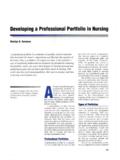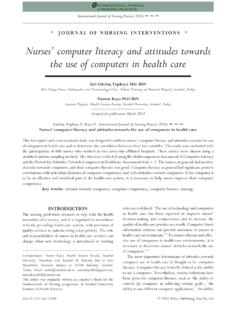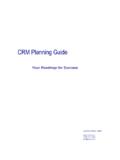Transcription of Influencing Health Care Policy
1 Influencing Health care Policy NURSING 4111: How Nurses Can Change Health care PolicyHealth Policy DevelopmentIncludes Four Developmental Components: Policy Process = government sets public Policy : Phases: formulation, implementation, evaluationPolicy Reform = changes in programs & practices reforming priorities, institutions, organizations, financing, regulatory environmentPolicy Environment = the arena the process takes place in, government, media, public Policy Makers = major players or key stakeholders in Policy environment How Nursing Fits the ProcessPolicy Process Nurses in government positions; governing org'ns develop dialogue with govt; research into key issuesPolicy Reform keep informed & involved and participate in lobbying, decisions, polls, mtgsPolicy Environment Visibility, media, let Position be known, Publish, Be involvedPolicy Makers Be part of this group, Be seen as credible, Show value of nurses' contributionRationalist Approach Based on scientific thought of 1960s and 1970sExample.
2 Management by objectives (MBO)Start with objectives, work outwards sans biasCentralized Policy Development, Top Down Nil to little input from key stakeholdersGood when little infrastructure in place, Education, Organized labour, professional groups Incrementalist ApproachBegins with what currently exists and where to go from thereLess mechanical than rationalist approachMore interactional between players and interestsHigh level of consultation with stakeholdersNurses should be highly involved in BOTH rationalist and incrementalist approachesNurses should be In Health Policy policies developed within the Health sector with government, etc. In Policies relevant to Health policies that impact on Health and Health services, Housing, Food and Tobacco Industries, public Water supply, Traffic Control, Social Security and the Social determinants of Health in generalHow Nurses can get InvolvedKeep up to date on developmentsWrite and publishJoin special interest organizationsKnow who the key players areKnow the key nursing positions and networksIdentify nurses in influential positions outside of nursing Communicate your position through lobbying, committees or boards, submissions, meeting with influential people.
3 Ongoing representation on Policy -makingNational Nursing OrganizationsShould lobby to ensure inclusion of nursesPosition the organization as an expert resourceBe alert to Health and public issuesStrategically engage in Policy process involvementForm strategic alliances with other organizationsProvide clear public, written statements on positionUnify position with other nursing organizationsEducate members about Policy issuesPrepare young nurses for leadershipAppoint expert, prepared, articulate speakersEffective PreparationNurses and students need to be taught to develop:Confidence in public speakingSkill in engaging in challenging discussionsTo defend positions publiclyQuestion the opinions and statements of othersBe articulate and effective leadersAccurately educate others about the issuesLobbying, change agent, community development skillsNew Models of CareNeed to recognize the need for changeVision for RenewalDevelop Champions for ChangeSet up supportive structures and activitiesInterdisciplinary Collaboration is important, especially with new Primary Health care modelCanadian public would prefer that doctors work as part of a team in hospital and communityPrimary Health care Transition Fund (2000)
4 Was created to address this issue and influence Policy initiatives Citizen's Visions of PHCC overage of Drugs, Dental, Preventative, RehabSingle, coordinated point of service delivery in one location with collaborative team servicesHolistic, responsive, high quality, client focused24/7 accessReadily available information to understand service availability and to support self-careWould welcome seeing a nurse for routine Health services, ear/throat infections, immunizations, manage diabetes, monitor blood pressure, check wound healing, etc. Professional Models of CareProfessional Contact Model include private practice doctors, physiotherapists, chiropractors, optometrists, psychologists and associated nursesProfessional Co-ordination Model coordinates a range of Health services, to facilitate continuity of care . Primary providers = doctors and nurses with blended funding mechanismsIntegrated Community Model promotes continuity and coordination of services across disciplines through networks 24/7 Non-integrated Community Model community based care without integration or much collaboratio










